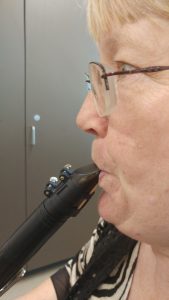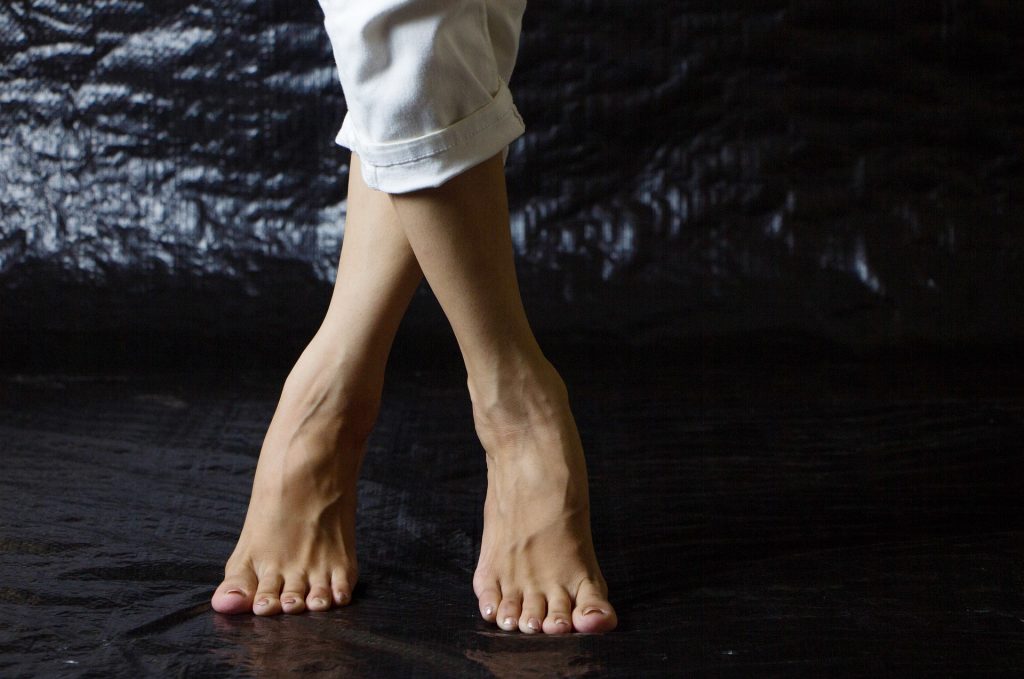For many years, I’ve been fascinated with sound resonance. I guess much of that came out of working with musical acoustics specialists during the writing of my dissertation. My topic was a strange one – looking inside the mouths of clarinet players to see how the tongue moved while playing. If you know anything about playing the clarinet, or any wind instrument for that matter, it’s rather difficult to see inside the mouth while you’re playing. It’s been an area of the unknown until people, like myself, started delving into these mysteries. It’s possible to do with medical equipment but I’ll not go into that here.
As a clarinetist, I have a unique perspective in how the body reacts to resonant frequencies. The clarinet and saxophone are the only two wind instruments where the teeth actually come in contact with part of the instrument – the mouthpiece. Oboe and bassoon players? They use what’s called a “double lip” embouchure where both lips cover the teeth and the reed sits between both lips. Clarinet and sax players put their top teeth on the mouthpiece. Brass and flute players hold the instrument up to their lips. No part of the mouthpiece goes inside the mouth. All wind players “feel” the vibrations of the instrument but clarinet and saxophone players feel resonance at a deeper level because the instrument actually touches our teeth.
 We all know that when anything has direct contact with the teeth, you’re going to feel that through your body pretty well. Many young clarinet and sax players often complain about this feeling, which is why some try to cover their top teeth with the upper lip. That makes their embouchure “double lip.” Both lips (upper and lower) come in contact with the mouthpiece. Although the double lip embouchure is used on the clarinet, it’s not a wide practice. For beginners, it’s not a good idea because it requires too much control to learn this method. The picture I’ve included is my lovely embouchure (the way I hold the instrument in my mouth) during a lesson where I was demonstrating to a student what a good clarinet embouchure looks like. For you, it’s simply a visual to help you understand what I’m talking about. Yes, we’re getting up close and personal.
We all know that when anything has direct contact with the teeth, you’re going to feel that through your body pretty well. Many young clarinet and sax players often complain about this feeling, which is why some try to cover their top teeth with the upper lip. That makes their embouchure “double lip.” Both lips (upper and lower) come in contact with the mouthpiece. Although the double lip embouchure is used on the clarinet, it’s not a wide practice. For beginners, it’s not a good idea because it requires too much control to learn this method. The picture I’ve included is my lovely embouchure (the way I hold the instrument in my mouth) during a lesson where I was demonstrating to a student what a good clarinet embouchure looks like. For you, it’s simply a visual to help you understand what I’m talking about. Yes, we’re getting up close and personal.
Back to my dissertation. The musical acoustics professor I worked with happened to live in Australia. I don’t remember how we connected but for three years, we had regular conversations. He took special interest in my project and gave me a lot of insight into resonant frequencies and how they operate inside the oral cavity while playing a musical instrument. In a nutshell, when you’re playing, the air inside your mouth will begin to oscillate at the same frequency as the note being played. Wind players innately sense this and will adjust their tongue position so the “voicing” of the note brings about the best resonance. Wind players use this “feeling” to help determine good tone quality. Most have no clue this is what they’re doing but by the videos taken during my dissertation, I could see this happening. It’s very noticeable on longer notes. When the two frequencies “lock in,” you can actually feel it through your whole body. This is a form of entrainment where two frequencies align with one another. If you were ever in band, you’ll probably remember that on certain notes, the snare drum would start to resonate. It’s the same thing – two identical resonant frequencies entrain with one another.
This is where the teeth coming into contact with the mouthpiece makes it much more noticeable. I began to pay attention to how my body responded to the vibrations sent through my teeth while playing the clarinet. There’s a deaf percussionist who “hears” music through her body. Her name is Evelyn Glennie and if you CLICK HERE, you can watch an interview where she explains what part of her body resonates for each note she hears and plays.

Image by Pixabay
Think about how our bodies are resonating chambers. Because I play the clarinet, I actually feel the resonating of the musical frequencies go through my teeth and into my body. Not only does a specific part of the body resonate but the whole body responds to frequencies from musicians playing near you. You can hear it through your ears, too. When the frequencies inside the mouth match the resonating frequencies of a specific note, there’s a deeper ringing in the ears. This takes time for young clarinet (and sax) players to get used to. I think because the teeth touch the instrument, we’re more sensitive to the frequencies flowing through us. For Evelyn Glennie, she feels it through her feet. She literally knows what notes she’s playing by the body part that’s resonating while she’s playing.
What does this mean for the general population? First off, this shows you that through looking at how wind musicians respond to vibration, our bodies resonate with what’s put into us. Secondly, think about all the sounds and vibrations around you every day. What about the music you listen to? What about conversations you have with people? Words create frequency so everything with any resonant frequency is going to resonate through your body. And, since we’re made up of at least 70% water, we are literally beings of resonant frequency.
There are many rabbit trails we could take from this introduction. Knowing that a different part of your body resonates for each note played (or sung) should help you understand that our bodies are indeed resonating chambers. For Evelyn, she can also feel the orchestra playing through her feet. This is how she’s able to play at the same tempo even with her back to the orchestra. If she can “hear” music through her body, so can the rest of us. Our only problem is that our “ear gates” take over the “feeling gates” because we’re so used to hearing a musical pitch and not feeling it. People who are blind or deaf generally rely upon heightened versions of the remaining senses to compensate for the loss of seeing or hearing.
Evelyn also has another weapon up her sleeve. She can read music and that gives her the ability to “see” what the orchestra is doing. At some point, she knows it so well she no longer needs to see the sheet music. She has the ability to feel the music through her feet at the same time she’s watching the little black dots on a page of sheet music. Her entire body becomes part of the music making process.
This has huge implications for therapeutic purposes. I’ve written several blog posts on studies where scientists are using resonance for the purposes of healing. Ultra sound is one of those. In addition, Royal Raymond Rife’s research is now being carried to another level. Scientists are determining the exact frequencies that can kill various diseases. If we think about what sounds are around us every day, it might be a bit easier to understand why some sounds drive us nuts. And, what other sounds are more pleasing to us. If anything, this should help us take an inventory of what’s in our world around us, deciding what can go and what can stay.

Image by Pixabay
Unfortunately, I think people who live in large cities might struggle a bit more with blocking out the sounds of a busy city in order to pay attention to what is resonating in their bodies. There’s probably a bit of over-stimulation going on for people who are constantly around noise and general busyness. I would venture to guess that as we continue to pay attention to the sounds around us, then choose what to let in, we’ll have the opportunity to live in a better state of health – physically and emotionally.
So, what if you do live in a place where there’s a lot of “noise pollution?” Maybe you can bring nature sounds into your home. Listen to calming and relaxing music in places where you can get away from it all. This may be why so many people shove a set of earbuds in their ears when they head out the door. It’s literally a way of blocking out the noise around them. The only problem with this practice is to make sure the decibel levels are low enough that there’s no damage to your hearing.
We are resonant beings of frequency. We literally resonate to everything around us. That’s why it’s important to choose wisely what we let into our personal space. Words, music, the games we play, what comes out of the TV (or radio), and the sounds around us do affect us. As we all walk through the pathway into healing, what we put into us (in addition to food) can have positive or adverse affects on us. Although some things we can’t control, there are many that we can control. In a sense, our path to wholeness totally depends on our choices.
If you would like suggestions of my music that can help bring you a sense of peace in a busy environment, try the following albums: New Hope (regular version), I AM, and Open Gates.
May your choices be good for your health – physically and emotionally!
© 2018 by Del Hungerford


[…] check out the four articles on this site (under the blog posts) about water memory. We are also beings of resonant frequency. It seems that everywhere we turn, we learn more about the function of frequency. Even in this […]
[…] The article I’ll focus on next is titled “The Physics and Biophysics of Sound Healing” by William Softkey. Softkey is a neuroscientist and biophysicist. He looks at sound baths from the neuroscientific point of view. He provides links to three of his papers that are very techie but for those who enjoy those types of articles, happy reading! In talking about sound, Softkey states, “Every last one of [our] body motions, from seconds to microseconds, is a kind of vibration and thus a kind of sound. You could say that a brain’s primary task, even the “visual” task of vibrating the eyeball, is that of anticipating and re-creating vibrations in space. Our brilliant brains are jelly managers.” He then goes on to say that in a sense, our brain and body is a self-playing instrument. That ties in with my article “We Are Resonant Beings of Frequency.” […]